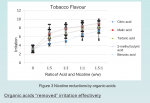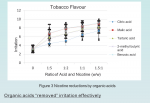Dehydration of GL to benzene has been observed [
11], and in e-cigarettes a simple dehydration stoichiometry could be PG + GL = benzene + 5 H2O (
Fig 1A). A second route to benzene in e-cigarettes is decarboxylation of benzoic acid (
Fig 1B), and benzene has been known to form when benzoic acid is used as a preservative in beverages.[
12] (Benzoic acid has been found by our laboratory in 14 out of 150 e-liquid refill products at levels estimated to be in the range 0.02 to 2 mg/mL, and benzoic acid is an acknowledged ingredient in e-liquids in the JUUL product line.[
13]) For a third route to benzene, many aromatic aldehydes are major e-liquid flavor additives, including benzaldehyde (for “cherry”), vanillin, and ethyl vanillin: aldehyde levels as high as several percent (by mass) have been found.[
14] Every aldehyde can be oxidized to its corresponding carboxylic acid, which may then undergo decarboxlation. Thus, oxidation of benzaldehyde can give benzoic acid, and therefore, benzene (
Fig 1C). For a fourth route to benzene, in what amounts to abiotic fermentation, an aldehyde can undergo redox disproportionation to form a mix of the corresponding alcohol and the acid, and the latter may then undergo decarboxylation. (The acid is more oxidized then the aldehyde, and the alcohol is less oxidized than the aldehyde.) With benzaldehyde, a mix of benzoic acid and benzyl alcohol can then be formed (
Fig 1D). (The disproportionation of an aldehyde lacking an “alpha-position” hydrogen atom is the Cannizzaro reaction, which is base-catalyzed (possibly then, by nicotine).)
From:
http://journals.plos.org/plosone/article?id=10.1371/journal.pone.0173055


